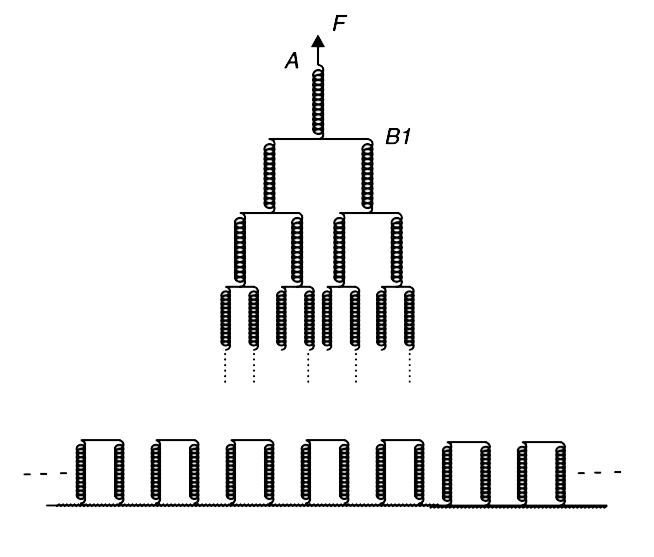Draw a plot of spring force versus displacement x. Hence find an expression for the P.E. of an elastic stretched spring.
To solve the problem, we will follow these steps:
Step 1: Understand the Spring Force
The force exerted by a spring is given by Hooke's Law, which states that the force F exerted by a spring is proportional to the displacement x from its equilibrium position. Mathematically, this is expressed as:
F=−kx
where:
- F is the spring force,
- k is the spring constant,
- x is the displacement from the equilibrium position.
Step 2: Draw the Plot of Spring Force vs. Displacement
To plot the spring force versus displacement:
- The x-axis will represent the displacement x.
- The y-axis will represent the spring force F.
- Since the force is negative for positive displacement and positive for negative displacement, the graph will be a straight line passing through the origin with a negative slope.
The plot will look like this:
- For x>0, F<0 (force acts in the opposite direction).
- For x<0, F>0 (force acts in the opposite direction).
Step 3: Calculate the Potential Energy of the Stretched Spring
The potential energy (P.E.) stored in a spring when it is stretched or compressed can be derived from the work done on the spring. The work done W on the spring when it is displaced from 0 to x is given by:
W=∫x0Fdx
Substituting F=−kx:
W=∫x0(−kx)dx
Step 4: Perform the Integration
Now, we calculate the integral:
W=−k∫x0xdx
W=−k(x22)x0
W=−k(x22−0)
W=−kx22
Since the work done on the spring is stored as potential energy, we take the negative of this value:
P.E.=12kx2
Step 5: Final Expression for Potential Energy
Thus, the expression for the potential energy of an elastically stretched spring is:
P.E.=12kx2
Summary of Steps
1. Understand the spring force using Hooke's Law.
2. Plot the spring force versus displacement, noting the negative slope.
3. Set up the work done as an integral of the force.
4. Perform the integration to find the work done.
5. Conclude with the expression for potential energy.
The force exerted by a spring is given by Hooke's Law, which states that the force F exerted by a spring is proportional to the displacement x from its equilibrium position. Mathematically, this is expressed as:
F=−kx
where:
- F is the spring force,
- k is the spring constant,
- x is the displacement from the equilibrium position.
To plot the spring force versus displacement:
- The x-axis will represent the displacement x.
- The y-axis will represent the spring force F.
- Since the force is negative for positive displacement and positive for negative displacement, the graph will be a straight line passing through the origin with a negative slope.
- For x>0, F<0 (force acts in the opposite direction).
- For x<0, F>0 (force acts in the opposite direction).
The potential energy (P.E.) stored in a spring when it is stretched or compressed can be derived from the work done on the spring. The work done W on the spring when it is displaced from 0 to x is given by:
W=∫x0Fdx
W=∫x0(−kx)dx
Now, we calculate the integral:
W=−k∫x0xdx
W=−k(x22)x0
W=−k(x22−0)
W=−kx22
P.E.=12kx2
Thus, the expression for the potential energy of an elastically stretched spring is:
P.E.=12kx2
1. Understand the spring force using Hooke's Law.
2. Plot the spring force versus displacement, noting the negative slope.
3. Set up the work done as an integral of the force.
4. Perform the integration to find the work done.
5. Conclude with the expression for potential energy.
Topper's Solved these Questions
Similar Questions
Knowledge Check
There are two springs P and Q . Spring constant for P is K and that for Q is 3K . Both the springs are elongated by applying force of same magnitude . If U is energy stored in spring P then energy stores in spring Q is
A3UBU/3C9UDU/9The elastic potential enegry of a stretched spring is given by E=50x2. Where x is the displacement in meter and and E is in joule, then the force constant of the spring is
A50 NmB100Nm−1C100N/m2D100 Nm
Show that the elastic force of a spring is a conservative forcce. Hence write an ex,pression for the petenial energy of an elastic stretched spriing.
View SolutionDiscuss the conservation of energy in an elastic spring. Hence write an expression for the maximum speed of a body of massin oscillating at its one end.
View SolutionIf a body of mass m suspended by a spring comes to rest after a downward displacement y0 find
(a) the force constant of the spring,
(b) loss in gravitational potential energy and
(c) gain in elastic potential energy.
View SolutionA spring of spring constant k is stretched by distance r. Obtain formula for elastic potential energy of a stretched spring. Plot graph of energies versus distance.
View SolutionDoes potential energy of a spring decrease / increase when it is compressed or stretched ?
View SolutionThe fig. shows an infinite tower of identical springs each having force constant k. The connecting bars and all springs are massless. All springs are relaxed and the bottom row of springs is fixed to horizontal ground. The free end of the top spring is pulled up with a constant force F. In equilibrium, find
(a) The displacement of free end A of the top spring from relaxed position.
(b) The displacement of the top bar B1 from the initial relaxed position.

View Solution
